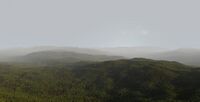Hartridge (Freedonia): Difference between revisions
| Line 161: | Line 161: | ||
===Climate=== | ===Climate=== | ||
Hartridge has a mild '''Humid Subtropical Climate'''. The city experiences plenty of rainfall evenly distributed throughout the year. Warm to mild temperatures are common. The city receives on average 76 inches of rainfall each year. With 168 days of precipitation recorded on average each year. As a result of sitting between two bodies of water, the temperatures are milder and conditions are humid throughout most of the year than the surrounding suburbs and rural areas. | |||
A record high of 104°F was recorded on January 18, 1998 at the height of a 7 day stretch of 90°F+ temperatures. A record low of 27°F was recorded on July 5, 2003. The wettest month was January of 1992 with 25 inches recorded. The driest month was March of 2018 with 1 inch of rainfall. The wettest year was 1934 with 120 inches of rainfall recorded. The driest year was 2016 with 36 inches of rainfall. | |||
Heatwaves are considered when temperatures reach or exceed 90°F in the city for 2 days or more. A coldwave or cold snap is declared when temperatures are 10°F degrees below the average high temperature for 2 days or more. Snow has been reported on multiple occasions during the 19th century, 24 times during the 20th century, and just 4 times during the 21st century. The most recent event was when 1-3 inches of snow fell in the city on July 28, 2019. The heaviest snowfall ever recorded was on July 18, 2008 with 6-7 inches of snow reported across the city. | |||
{{Weather box|width=auto | {{Weather box|width=auto | ||
|location = Downtown Hartridge, Southland, Freedonia, 1991–2020 normals, extremes 1944–present | |location = Downtown Hartridge, Southland, Freedonia, 1991–2020 normals, extremes 1944–present | ||
Revision as of 23:06, 28 March 2022
Hartridge | |
|---|---|
City-County/ Regional Capital | |
From Top to bottom: Hartridge CBD (Downtown Hartridge), Bayside Neighborhood, Spring Canal Neighborhood, Spring Canal Neighborhood during a rainstorm, Lake Hannah Recreational Area during the day, Lake Hannah Recreational Area during the night, Hartridge Botanical Gardens, Hartridge Central High School, Hartridge University campus, Residential street in the Flowerland Neighborhood, Hartridge Forest Park | |
| Nickname(s): Spring City, Garden City, City by the Lake | |
| Country | Freedonia |
| Region | Southland |
| Founded by | Cornell Hartridge |
| Government | |
| • Mayor | Sophia Swason (GSP) |
| Area | |
| • City-County/ Regional Capital | 342 sq mi (890 km2) |
| • Land | 180 sq mi (500 km2) |
| • Water | 162 sq mi (420 km2) |
| • Urban | 130 sq mi (300 km2) |
| • Rural | 50 sq mi (100 km2) |
| • Metro | 1,700 sq mi (4,000 km2) |
| Elevation | 63 ft (19 m) |
| Population (2022) | |
| • City-County/ Regional Capital | 128,000 |
| • Density | 711.12/sq mi (274.56/km2) |
| Population Density based on Total Land Area | |
| Demonym | Hartridgeain |
| Time zone | Freedonia Time |
Hartridge also known as Hartridge City is the largest city and capital of Southland. It is the nation's tenth largest city. Hartridge is known for its natural beauty, lake shore, beach shore, mountain, and forest views. Hartridge University is located in the city. Hartridge has a population as of the 2022 census, of 128,000 people living in the Municipality. Only 125,000 people live in the urban area of the Municipality. 190,000 people live in the Metropolitan Area of Hartridge. Hartridge is located on an narrow area between Lake Hannah and the (Hartridge Bay) Toyana Ocean. With the Spring Canal connecting the two bodies of water.
History
Geography
The City County of Hartridge is the smallest county by land area in Southland. Located between Lake Hannah, Hartridge Bay which opens up to the Cantalle Ocean, and the Southerland Mountains. The city rapidly rises from sea level to 50-75 feet in elevation. In some places on the north and south ends of the city, hills reach elevations of 120 to 130 feet.
Lake Hannah is the largest lake in Freedonia at 182 square miles. Of which 48 square miles of the lake is owned by the Hartridge Municipality. The Municipality also faces Hartridge Bay which is 690 square miles in area. The Municipality owns 114 square miles of the bay. The remaining area is divided between Urban and Rural. The Urban Area is 130 square miles. 13 miles east to west in length. And 10 miles north to south in width.
Outside of this area to the north is the Hartridge Forest Park, at 18 square miles. It is mountainous and heavily forested. The remaining 32 square miles are rural in nature. With about 3,000 residents living in this area.
In 1973 the Spring Canal was completed, connecting Lake Hannah and Hartridge Bay. The Area prior to this was well known for flooding during heavy rainfall as well as flooding from Lake Hannah overflowing it's banks. The area as a result was left as a natural flood plain, dividing the northern and southern parts of the city. The Area was raised from a elevation of 29 feet to 63 feet during the 1980's. The area during the 1990's was developed into a mixed use area of high density commerical and housing.
Downtown Hartridge was built along the new lands. The Central Business District is located along the banks of Spring Canal and the Bayshore. The city is still at risk of flooding, though not to the extent prior to 1973.
Climate
Hartridge has a mild Humid Subtropical Climate. The city experiences plenty of rainfall evenly distributed throughout the year. Warm to mild temperatures are common. The city receives on average 76 inches of rainfall each year. With 168 days of precipitation recorded on average each year. As a result of sitting between two bodies of water, the temperatures are milder and conditions are humid throughout most of the year than the surrounding suburbs and rural areas.
A record high of 104°F was recorded on January 18, 1998 at the height of a 7 day stretch of 90°F+ temperatures. A record low of 27°F was recorded on July 5, 2003. The wettest month was January of 1992 with 25 inches recorded. The driest month was March of 2018 with 1 inch of rainfall. The wettest year was 1934 with 120 inches of rainfall recorded. The driest year was 2016 with 36 inches of rainfall.
Heatwaves are considered when temperatures reach or exceed 90°F in the city for 2 days or more. A coldwave or cold snap is declared when temperatures are 10°F degrees below the average high temperature for 2 days or more. Snow has been reported on multiple occasions during the 19th century, 24 times during the 20th century, and just 4 times during the 21st century. The most recent event was when 1-3 inches of snow fell in the city on July 28, 2019. The heaviest snowfall ever recorded was on July 18, 2008 with 6-7 inches of snow reported across the city.
| Climate data for Downtown Hartridge, Southland, Freedonia, 1991–2020 normals, extremes 1944–present | |||||||||||||
|---|---|---|---|---|---|---|---|---|---|---|---|---|---|
| Month | Jan | Feb | Mar | Apr | May | Jun | Jul | Aug | Sep | Oct | Nov | Dec | Year |
| Record high °F (°C) | 104 (40) |
101 (38) |
97 (36) |
93 (34) |
88 (31) |
83 (28) |
79 (26) |
80 (27) |
84 (29) |
86 (30) |
92 (33) |
98 (37) |
104 (40) |
| Average high °F (°C) | 79 (26) |
78 (26) |
75 (24) |
73 (23) |
70 (21) |
67 (19) |
65 (18) |
66 (19) |
68 (20) |
71 (22) |
74 (23) |
77 (25) |
72 (22) |
| Average low °F (°C) | 60 (16) |
57 (14) |
54 (12) |
51 (11) |
48 (9) |
45 (7) |
42 (6) |
44 (7) |
48 (9) |
52 (11) |
56 (13) |
59 (15) |
51 (11) |
| Record low °F (°C) | 48 (9) |
45 (7) |
40 (4) |
37 (3) |
34 (1) |
30 (−1) |
27 (−3) |
28 (−2) |
32 (0) |
35 (2) |
42 (6) |
46 (8) |
27 (−3) |
| Average precipitation inches (mm) | 6.78 (172) |
6.31 (160) |
6.13 (156) |
6.29 (160) |
5.98 (152) |
6.56 (167) |
6.71 (170) |
6.12 (155) |
6.37 (162) |
6.56 (167) |
6.03 (153) |
6.17 (157) |
76.01 (1,931) |
| Average precipitation days (≥ 0.01 in) | 16 | 15 | 14 | 12 | 14 | 15 | 15 | 14 | 13 | 12 | 13 | 15 | 168 |
| Source: Freedonia Weather Service | |||||||||||||
Parks and Gardens
Demographics
| Historical population | ||
|---|---|---|
| Year | Pop. | ±% |
| 1852 | 101 | — |
| 1862 | 152 | +50.5% |
| 1872 | 223 | +46.7% |
| 1882 | 398 | +78.5% |
| 1892 | 656 | +64.8% |
| 1902 | 2,743 | +318.1% |
| 1912 | 6,079 | +121.6% |
| 1922 | 18,978 | +212.2% |
| 1932 | 29,145 | +53.6% |
| 1942 | 36,238 | +24.3% |
| 1952 | 42,445 | +17.1% |
| 1962 | 47,019 | +10.8% |
| 1972 | 58,745 | +24.9% |
| 1982 | 64,568 | +9.9% |
| 1992 | 72,166 | +11.8% |
| 2002 | 82,898 | +14.9% |
| 2012 | 98,766 | +19.1% |
| 2022 | 128,043 | +29.6% |










